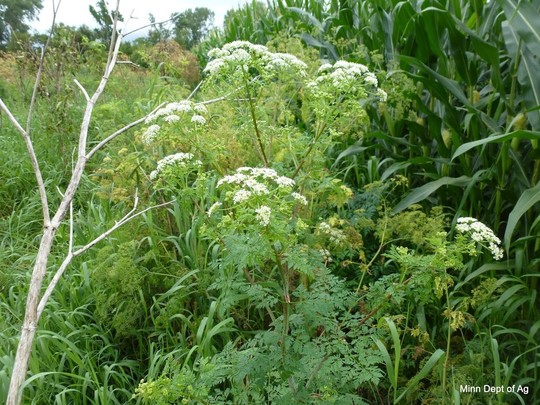|
Having trouble viewing this email? View it as a Web page.
January 31, 2022
February Weed of the Month: 2021 New County Finds of Prohibited Eradicate Noxious Weeds
Emilie Justen, Minnesota Department of Agriculture
A noxious weed is defined by the Minnesota Noxious Weed Law as an annual, biennial, or perennial plant that the Commissioner of Agriculture designates to be injurious to public health, the environment, public roads, crops, livestock, or other property. Noxious weeds are categorized into four regulatory categories: Prohibited Eradicate, Prohibited Control, Restricted, and Specially Regulated. The highest priority weeds are Prohibited Eradicate. To prevent these species from becoming widespread throughout the state, the law states that all above and below ground plant parts of Prohibited Eradicate species must be destroyed.
 Poison hemlock has white flowers, looks similar to wild carrot, and grows in moist areas and along rights of way.
Click here to download the photo
Collaboration with multiple agencies, organizations, and private landowners throughout the state helps the Minnesota Department of Agriculture (MDA) successfully detect Prohibited Eradicate noxious weeds. In 2021, six Prohibited Eradicate species were confirmed for the first time in 14 counties.
Species
|
County
|
|
Brown knapweed (Centaurea jacea)
|
Washington
|
|
Common teasel (Dipsacus fullonum)
|
Dakota, Ramsey,
Yellow Medicine
|
|
Cutleaf teasel (Dipsacus laciniatus)
|
St. Louis
|
|
Meadow knapweed (Cenaurea x moncktonii)
|
Dakota
|
|
Palmer amaranth (Amarannthus palmeri)
|
Clay, Goodhue,
Polk
|
|
Poison hemlock (Conium maculatum)
|
Brown, Le Sueur,
Lyon, Mower,
Washington
|
Brown knapweed is an herbaceous perennial with small pinkish-purple flowers and grows in sunny, wet areas. Common teasel and cutleaf teasel are closely related monocarpic perennials, meaning they die after flowering, have spiny, stiff flower and seedheads; they prefer sunny, open habitats such as roadsides or pastures. Meadow knapweed is a deep-rooted perennial with pink flowers that grows in sunny, wet conditions. Palmer amaranth is a high-profile noxious weed of row crops, and the MDA publishes media releases as soon as the information can be made public. Poison hemlock is a highly toxic plant that has white flowers, looks similar to wild carrot, and grows in moist areas and along rights of way.
The MDA verifies all reports and collects voucher samples, when possible, for the official University of Minnesota herbarium records. As the regulatory agency for managing noxious weeds, the MDA also helps local governments with weed management and enforcement of the Minnesota Noxious Weed Law. The MDA provides training to the County Agriculture Inspectors (CAIs) while the CAIs enforce the Minnesota Noxious Weed Law.
MEDIA: For more information on Weed of the Month, contact Allen Sommerfeld, MDA Communications, at allen.sommerfeld@state.mn.us or 651-201-6185
|